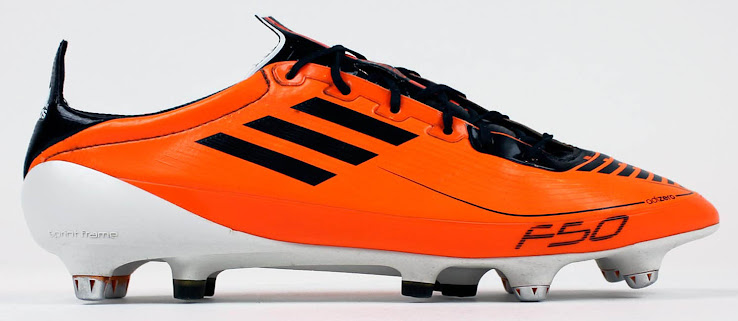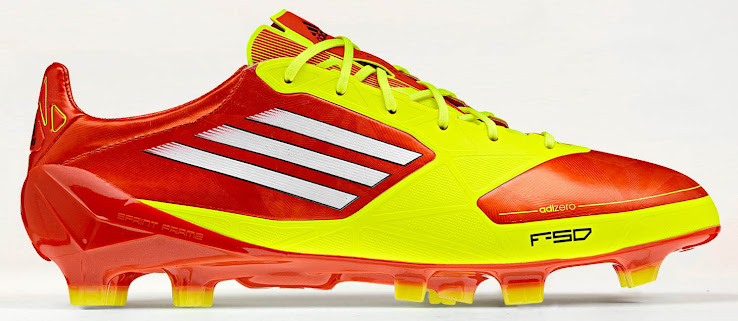Say goodbye. Adidas Discontinues F50 Adizero Boots
The end of an era. After 11 years, Adidas will stop making the popular Adidas F50 Soccer Cleats, which were introduced prior to the EURO 2004. We take a look at the most famous Adidas F50 Adizero Soccer Cleats, and provide a brief overview of the history of the Adidas F50 Football Boot.
Adidas F50 Boots - The beginnings
The first Adidas F50 Boot was released in 2004.
In 2004, Adidas released the totally new Adidas F50 Cleats to compete with the Nike Mercurial Vapor silo. Featuring a soft Kangaroo leather upper, while hiding the laces for a larger striking surface, the first Adidas F50 Cleat have little to do with the modern 2015 Adidas F50 Adizero Soccer Boot. The name of the Adidas F50 (Football 50) Boots draws inspiration from Football (F), and the 50-years anniversary of Germany's 1954 World Cup title.
In 2006, Adidas revealed the first interchangeable football boot, the all-new Adidas +F50.6. The revolutionary Adidas +f50.6 allowed players to build their own boot with different sockliners, sole-plate and upper options. But players like Lionel Messi didn't like the new Adidas +f50.6 Boots and famously opted for the lower-tier Adidas f30 Boots, which is scarcely still imaginable today.
In the following years, Adidas launched three new generations of the Adidas F50 Cleats, which featured a similar concept of a interchangeable boot (Adidas +f50.8 TUNIT, Adidas +f50.9 TUNIT, Adidas +f50.i). The most famous boot of the Adidas F50 is definitely the first signature Adidas Messi f50.i Boot, which he kissed after scoring in the 2009 UEFA Champions League Final.
Adidas Reveals F50 Adizero - Lightest Ever Football Boot
Adidas F50 Adizero Chameleon Purple.
In 2010, Adidas discontinued the interchangeable boot system and released their first-ever speed boot weighing in at staggering 165 gram. The first Adidas F50 Adizero Soccer Cleat introduced a new era for Adidas, who released a black / yellow launch colorway and the famous Adidas Messi Chameleon Purple 2010 World Cup Cleats. The first Adidas F50 Adizero Boot marked the beginning of a success story featuring lightweight materials and a Sprintframe outsole.
The revolutionary Adidas F50 Adizero Prime Soccer Cleats tip the scales at 145g, which made them the lightest football boot at that time. Introduced in 2011 with a bright orange paint job, the Adidas F50 Adizero Prime Boots featured a ultra-thin upper and a lightweight Sprintframe sole plate. The Adidas F50 Adizero Prime Boot remained the lightest football boot until 2014.
The second generation of the Adidas F50 Adizero Boots was released in 2011, introducing the all-new Adidas miCoach system. Weighing in at 165g, the Adidas F50 Adizero III Cleat put emphasis on performance rather than, as previously, producing the lightest possible football boot. The Adidas F50 Adizero Boot is still considered as the best-ever generation of the Adidas Adizero.
In November 2012, Adidas introduced the third generation of the Adidas F50 Adizero Boots featuring a new upper material, while the sole plate remained unchanged. Lionel Messi debuted the yellow Adidas F50 Adizero Cleats in the now famous UEFA Champions League match against Celtic.
One year later, in November 2014, Adidas launched the second last Adidas F50 Adizero Boot, part of the Adidas Samba Football Boots Collection. The Adidas F50 Adizero Samba Boots featured a weight reduction to 150 gram, and introduced a new Hybridtouch upper and a lightweight Sprintframe outsole.
It was only four months ago that Adidas introduced the last generation of the Adidas F50 Adizero Boots. The Adidas F50 Adizero 2015 Soccer Boot ditched the miCoach slot, while introducing a totally new outsole with a second-level of traction.
It's time to say goodbye to the Adidas F50 Adizero. On May 18, Adidas announced the end of the Adidas 11pro, Nitrocharge, Predator and F50 Adizero Boots. Drop us a line below.






















